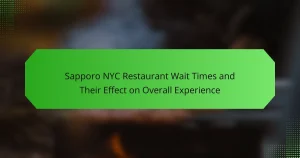
What are the pricing strategies used by Sapporo NYC Restaurant?
Sapporo NYC Restaurant employs several pricing strategies. These include competitive pricing, where prices are set based on competitors’ offerings. They also utilize value-based pricing, focusing on the perceived value of their unique dining experience. Seasonal pricing is applied to reflect changes in ingredient availability and demand. Additionally, Sapporo NYC offers promotional pricing during special events to attract customers. These strategies are designed to enhance customer perception of value while maintaining profitability.
How do these pricing strategies impact customer perceptions?
Pricing strategies significantly influence customer perceptions of value and quality. For example, premium pricing can create an image of exclusivity and superior quality. Customers often associate higher prices with better service and experience. Conversely, competitive pricing may lead customers to perceive value through affordability and accessibility. Psychological pricing, like ending prices in .99, can make items seem less expensive, impacting purchase decisions. Research shows that perceived value is closely linked to pricing strategies, with studies indicating that customers are willing to pay more for perceived quality. Therefore, effective pricing strategies can enhance customer satisfaction and loyalty.
What role does pricing play in the overall dining experience at Sapporo NYC?
Pricing at Sapporo NYC significantly influences the overall dining experience. It sets expectations for quality and service. Higher prices often indicate premium ingredients and skilled preparation. Guests may feel more valued when paying a premium. Conversely, lower prices can attract a wider audience. However, they may lead to perceptions of lower quality. Research shows that price affects customer satisfaction and loyalty. A balance in pricing enhances perceived value and encourages repeat visits.
How does Sapporo NYC differentiate its pricing from competitors?
Sapporo NYC differentiates its pricing from competitors by offering a unique value proposition focused on quality and experience. The restaurant emphasizes high-quality ingredients and authentic Japanese cuisine, which justifies its pricing strategy. Sapporo NYC also incorporates a premium dining atmosphere that enhances the overall guest experience. This combination of quality and ambiance allows Sapporo NYC to position itself as a higher-end option in the market. Competitors often focus on lower prices, but Sapporo NYC attracts customers willing to pay more for perceived value. Additionally, the restaurant frequently updates its menu to include seasonal and specialty items, maintaining customer interest and justifying its pricing. This strategy fosters customer loyalty and repeat visits, further solidifying its market position.
What factors influence the pricing decisions at Sapporo NYC?
Pricing decisions at Sapporo NYC are influenced by several factors. These include ingredient quality, location, and target market demographics. Ingredient quality affects costs and perceived value. Sapporo NYC sources high-quality ingredients, which justifies higher prices. The restaurant’s location in a competitive area impacts pricing strategies. Higher rent and operational costs lead to increased menu prices. Target market demographics also play a crucial role. Understanding customer preferences helps tailor pricing to maximize sales. Seasonal trends and economic conditions further influence pricing adjustments. These factors collectively shape the overall pricing strategy at Sapporo NYC.
How does the quality of ingredients affect pricing at Sapporo NYC?
The quality of ingredients directly influences pricing at Sapporo NYC. Higher-quality ingredients typically lead to increased costs for sourcing. This results in higher menu prices to maintain profit margins. For instance, premium seafood or organic vegetables are more expensive than standard options. Additionally, customers often associate quality with value. They may be willing to pay more for dishes made with fresh, high-grade ingredients. This perception enhances the overall dining experience. As a result, Sapporo NYC can position itself as a premium dining destination. Thus, ingredient quality and pricing are closely linked in their business strategy.
What is the impact of location on Sapporo NYC’s pricing strategy?
Sapporo NYC’s pricing strategy is significantly influenced by its location in a competitive urban market. The restaurant’s proximity to high-foot-traffic areas allows for premium pricing due to increased visibility and accessibility. Additionally, location impacts operational costs, including rent and utilities, which are typically higher in urban settings. This necessitates a pricing strategy that reflects these costs while maintaining perceived value. Market research indicates that restaurants in prime locations often charge 10-20% more than those in less desirable areas. This strategy aligns with consumer expectations for quality and service associated with such locations. Thus, Sapporo NYC’s pricing is a direct response to the economic realities of its urban environment.

How does perceived value of service affect customer satisfaction at Sapporo NYC?
Perceived value of service significantly influences customer satisfaction at Sapporo NYC. When customers believe they receive high-quality service, their satisfaction levels increase. This perception is shaped by factors such as staff attentiveness, food quality, and overall dining experience. Research indicates that a positive perceived value leads to repeat visits and recommendations. According to a study published in the Journal of Hospitality Marketing & Management, higher perceived value correlates with increased customer loyalty. This reinforces the importance of service quality in enhancing customer satisfaction at Sapporo NYC.
What elements contribute to the perceived value of service at Sapporo NYC?
Key elements contributing to the perceived value of service at Sapporo NYC include staff professionalism, ambiance, and menu quality. Professional staff enhances customer experience through attentive service. The restaurant’s ambiance creates a welcoming atmosphere that encourages guests to linger. High-quality menu items, featuring fresh ingredients, elevate dining satisfaction. Additionally, consistent service delivery builds customer trust and loyalty. Positive online reviews and word-of-mouth recommendations further reinforce the restaurant’s reputation. These factors collectively enhance the perceived value of the service offered at Sapporo NYC.
How do staff interactions influence the perceived value of service?
Staff interactions significantly influence the perceived value of service. Positive staff interactions enhance customer satisfaction and loyalty. Customers often associate high-quality service with friendly and attentive staff. Research shows that 70% of customers base their perception of value on service interactions. Staff demeanor, responsiveness, and knowledge contribute to this perception. For example, a study by the Journal of Service Research found that perceived service quality directly affects customer loyalty. Thus, effective staff interactions elevate the overall service experience, leading to higher perceived value.
What role does ambiance play in shaping perceived value at Sapporo NYC?
Ambiance significantly influences perceived value at Sapporo NYC. The restaurant’s design, lighting, and music create a unique dining experience. This atmosphere enhances customer enjoyment and satisfaction. Studies show that a well-crafted ambiance can lead to higher customer spending. For instance, research indicates that pleasant environments can increase perceived quality and willingness to pay. Sapporo NYC’s ambiance aligns with its brand identity, reinforcing the quality of its offerings. This strategic focus on ambiance contributes to a premium perception among patrons. Overall, ambiance plays a crucial role in shaping the perceived value of dining experiences at Sapporo NYC.
How can Sapporo NYC enhance perceived value through service improvements?
Sapporo NYC can enhance perceived value through targeted service improvements. Improving staff training can lead to better customer interactions. Enhanced menu knowledge among staff can result in more informed recommendations. Streamlining service processes can reduce wait times, increasing customer satisfaction. Offering personalized experiences can make guests feel valued and appreciated. Implementing feedback systems allows for continuous service enhancement based on customer preferences. Regular staff evaluations can maintain high service standards. These improvements can lead to higher customer retention and positive word-of-mouth, ultimately increasing perceived value.
What specific training can staff undergo to improve customer service perceptions?
Staff can undergo training in communication skills to improve customer service perceptions. Effective communication enhances interactions with customers. This training includes active listening techniques. Staff learn to understand customer needs better. Role-playing scenarios can be incorporated into training sessions. This method helps staff practice responses to various customer situations. Additionally, training in emotional intelligence is beneficial. It enables staff to empathize with customers. Research shows that 70% of customer perceptions are influenced by employee interactions. This highlights the importance of comprehensive training programs.
How can feedback mechanisms be utilized to enhance perceived value at Sapporo NYC?
Feedback mechanisms can enhance perceived value at Sapporo NYC by actively engaging customers in the service experience. Collecting customer feedback through surveys and reviews allows the restaurant to understand preferences and expectations. Addressing feedback promptly demonstrates responsiveness and commitment to customer satisfaction. Implementing changes based on feedback can lead to improved menu offerings and service quality. Research shows that restaurants that adapt to customer feedback see a 20% increase in customer retention. This retention boosts perceived value, as satisfied customers are likely to share positive experiences. Thus, effective feedback mechanisms directly correlate with enhanced perceived value at Sapporo NYC.

What are the best practices for aligning pricing strategies with perceived value at Sapporo NYC?
Best practices for aligning pricing strategies with perceived value at Sapporo NYC include conducting market research, understanding customer preferences, and analyzing competitor pricing. Market research helps identify the perceived value of offerings among target customers. Understanding customer preferences allows Sapporo NYC to tailor its menu and pricing to meet expectations. Analyzing competitor pricing ensures that Sapporo NYC remains competitive while reflecting its unique value proposition. Additionally, regularly soliciting customer feedback can provide insights into perceived value. Implementing value-based pricing can also enhance alignment between price and customer perception. These practices contribute to maximizing revenue while maintaining customer satisfaction.
How can Sapporo NYC effectively communicate its value proposition to customers?
Sapporo NYC can effectively communicate its value proposition to customers by clearly highlighting its unique offerings. This includes emphasizing the authenticity of its Japanese cuisine and the quality of its ingredients. Sapporo NYC should utilize targeted marketing strategies to showcase its signature dishes and dining experiences. Engaging visuals on social media platforms can attract potential customers. Customer testimonials can enhance credibility and demonstrate satisfaction. Additionally, special promotions or loyalty programs can reinforce perceived value. Providing detailed menus that explain dish origins can further educate customers about their choices. Regularly updating content can keep customers informed about new offerings and events.
What marketing strategies can be employed to highlight the value of service?
Effective marketing strategies to highlight the value of service include customer testimonials, service guarantees, and personalized experiences. Customer testimonials build trust by showcasing real experiences. Service guarantees reduce perceived risk, assuring customers of satisfaction. Personalized experiences enhance customer engagement and loyalty. Additionally, showcasing staff expertise can demonstrate value. Highlighting unique service attributes differentiates the restaurant from competitors. Utilizing social media to share service stories can amplify reach. Finally, offering loyalty programs rewards repeat customers and emphasizes service value.
How can customer testimonials be used to reinforce perceived value?
Customer testimonials can reinforce perceived value by providing social proof of quality. When potential customers read positive experiences from others, they gain confidence in the service. This validation can lead to increased trust and credibility for the restaurant. Research indicates that 79% of consumers trust online reviews as much as personal recommendations. Testimonials highlight specific attributes, such as excellent service or unique menu items. This specificity can enhance a restaurant’s appeal. By showcasing customer satisfaction, testimonials can effectively differentiate a restaurant in a competitive market. Ultimately, they contribute to a higher perceived value of the dining experience.
What tips can Sapporo NYC implement to optimize pricing and perceived value?
Sapporo NYC can optimize pricing and perceived value by conducting market research to understand customer preferences. This research should focus on competitors’ pricing and customer expectations. Implementing tiered pricing based on menu items can enhance perceived value. For example, offering premium options at higher price points can attract discerning customers.
Additionally, Sapporo NYC should emphasize the quality of ingredients and unique dining experience in marketing materials. Highlighting these aspects can justify higher prices. Regularly updating the menu with seasonal items can create a sense of exclusivity and urgency.
Offering limited-time promotions or discounts can also enhance perceived value without permanently altering pricing. Lastly, gathering customer feedback on pricing and value perceptions can inform future pricing strategies. This approach can ensure alignment with customer expectations and enhance overall satisfaction.
How can regular menu reviews enhance pricing strategy effectiveness?
Regular menu reviews can enhance pricing strategy effectiveness by ensuring alignment with market trends and customer preferences. These reviews allow restaurants to analyze sales data and customer feedback. This analysis helps identify high-performing and underperforming items. By adjusting prices based on this information, restaurants can optimize profit margins. Regular reviews also enable restaurants to respond to ingredient cost fluctuations. This responsiveness helps maintain profitability without sacrificing perceived value. Additionally, menu reviews can highlight seasonal items, encouraging customers to try new offerings. A study by the National Restaurant Association indicates that regular menu updates can lead to increased customer satisfaction and repeat business.
What role does customer engagement play in adjusting perceived value and pricing?
Customer engagement significantly influences perceived value and pricing. Engaged customers often perceive higher value in products and services. This perception allows businesses to justify premium pricing. For instance, restaurants that foster strong customer relationships can enhance loyalty. According to a study by Gallup, highly engaged customers are 23% more likely to spend on premium offerings. Additionally, customer feedback can lead to adjustments in pricing strategies. When customers feel valued, they are more willing to pay higher prices. Overall, effective customer engagement can lead to increased perceived value and optimized pricing structures.
Sapporo NYC Restaurant is the primary entity discussed in this article, focusing on its pricing strategies and the perceived value of its service. The article outlines various pricing strategies employed by the restaurant, including competitive, value-based, and seasonal pricing, as well as promotional tactics during special events. It explores how these strategies impact customer perceptions of value and quality, emphasizing the role of ingredient quality, location, and staff interactions in shaping the dining experience. Additionally, the article highlights best practices for aligning pricing with perceived value and the importance of customer engagement and feedback in optimizing pricing strategies.


